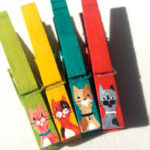 You invent a great character and you give her a worthy goal. She has tough obstacles to overcome in order to obtain this goal and also takes a couple of subplot side trips just to keep things interesting. Yet even with all of these ducks in a row, writers can and often do go off the rails as they draft. In revisions, what should be included and what should be cut? One way to better grasp the meat of your story is to construct a sort of clothesline.
You invent a great character and you give her a worthy goal. She has tough obstacles to overcome in order to obtain this goal and also takes a couple of subplot side trips just to keep things interesting. Yet even with all of these ducks in a row, writers can and often do go off the rails as they draft. In revisions, what should be included and what should be cut? One way to better grasp the meat of your story is to construct a sort of clothesline.
Writing Tip for Today: If you’ve ever struggled to stay true to the core story or theme of your work, a Story Clothesline might be just what your story needs.
Hot Mess Draft
Whether you’ve spent fifteen years writing a novel or you’ve just finished NaNoWriMo, the first (or second or third) draft of a novel is liable to be a hot mess. You know better than to give up, but the moment you wade into your draft, that brilliant advice from the pro editor you hired (you know, the words that sounded so logical and EASY to do?) suddenly seems impossible. It’s as if the pro was showing you the perfect version of your story from the top of a hill. You looked down and saw a beautiful, tidy forest of a novel or memoir. But when you venture into the forest, all you see are gigantic trees. And you don’t know where to start to implement that logical advice. You might even decide to put that hot mess on the back burner for an extra-long rest. But there is a way to tease out what is or what should be your story’s backbone.
Look for the Line
Before you get lost in the forest with no breadcrumbs to show you the way out, take some time to consider the cores of successful novels and memoirs. Chances are, these examples will have a predominant theme or motif that jumps out at you. For instance, in Cheryl Strayed’s Wild, a memoir, the author uses the Pacific Crest Trail as a kind of “clothesline” upon which she hangs different stories about her life as a way to explain her reason for this punishing trek. Jennifer Egan’s A Window Opens, features a clothesline made of the questions we ask surrounding women competing for work in the new kind of business model made popular by companies like Amazon, Google and Apple. And in Jennifer Lauck’s memoir Blackbird, a child’s loss of a parent to cancer is the clothesline to show her journey of survival. See if you can identify the “clothesline” in different stories you read, and then begin to articulate your story’s main theme or story line. This isn’t always easy, so a good critique partner or beta reader might help you if you don’t see the line right away. And if you can’t figure it out, you might have to rethink your story.
Don’t Run Aground!
When I was a kid, we hung our wet laundry on an old-fashioned outdoor clothesline. As I helped, my mother always admonished me not to let the bedsheets drag to the ground, lest they get dirty. The same is true for your story’s clothesline. You can hang different scenes or events along the line, but if you go too far afield of that central theme, your scenes will “touch the ground” and be ineffective at moving the story forward. If you are evaluating a scene or chapter for its relevance to the overall story, determine how close or far from the main story line the piece in question is. This method can be done figuratively or literally with twine strung across an open space and three-by-five cards hung at different points along it. The clothesline also functions as a timeline, and you can go forward and back (flashbacks) along the main clothesline. Doing so forces you to consider when and how much of back story the clothesline can handle before the main story starts to sag to the ground under its weight. If you experiment with the Story Clothesline in other ways, let me know how it works for you.




